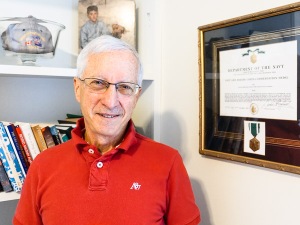“I think this place saved my life. I was in the DC area for seven years before I moved here. It was sucking the life out of me.”
Linda Eriksen came to Biltmore Lake in 2014 after 32 years in the US Army. Enlisting out of high school at the very end of the WACS program in 1977, she was promoted to 2nd Lieutenant from Staff Sergeant in 1986 in a rare direct commission. By her 2010 retirement she’d risen to Lt. Colonel assigned to the Joint Chiefs Staff where she worked in a think tank and on the Joint Staff of the new African Command (AFCOM).
“Working in the Joint Staff was amazing. I worked with incredibly intelligent people. I was an aide to a general, and I basically took care of all these guys and made sure they had everything they needed to do these smart things. They were putting together strategic plans for the President. What an honor to serve with these gentlemen.”
 From 2010 to 2014, she was a DOD contractor in the Pentagon, working for the Secretary of Defense and Secretary of the Army.
From 2010 to 2014, she was a DOD contractor in the Pentagon, working for the Secretary of Defense and Secretary of the Army.
Deployed to Kuwait and Iraq in 2006-07, she was in charge of policy & programs for 3rd Army, bringing in donations to the troops, making sure they were taken care of, and writing such policies as suicide prevention plans covering all 3rd Army troops in theater and at home. She was also in charge of naturalization ceremonies, “Which were amazing. There were so many troops that weren’t even American citizens, yet were putting their lives on the line. We did three naturalization ceremonies. Kids from all over came to Kuwait to do the ceremony so they’d become American citizens. That was incredible.”
During her service she earned a Bachelors Degree in Aviation, an MBA, and Masters Degrees in International Relations and Communications. She served briefly as a replacement air traffic controller during the Reagan Administration’s confrontation with the civilian air traffic controllers union.
Linda’s officer years were spent mostly in Active Guard Reserve career management. In her last year she managed 319 colonels. “It took a lot out of me because I couldn’t go home and not think about these people. When you move somebody, and you give them orders, it’s not just them, it’s their families, it’s their kids, it’s their dog, uprooting their lives. ”
Now settled in Asheville, “I’m retired, but I’m very involved. I’m a volunteer for the sheriff’s office, MANNA and 10,000 Villages, the free-trade store near Pritchard Park. I’m on the advisory board for Veterans’ Restoration Quarters. They have up to 250 homeless veterans in a [facility] on Tunnel Road. They help them get their lives together, get medical care, get them skills and jobs.”
Linda started the Biltmore Lake Military Veterans Group and is also on the BLHOA Safety Committee.
Residents know her by her gorgeous new Corvette. Her eighth, this is the first she’s ordered custom built.
Next on her schedule: at year’s end she is heading to the Ron Fellows Racing School in Las Vegas for two days of classes and time on the track. Corvettes and racing. “It’s my passion.”
This article originally appeared in The Biltmore Beacon newspaper.
 Family photographs, including a yellowed military portrait of a World War II relative, sit on a bookshelf. Several items of naval memorabilia are evident. On the wall I see framed service awards, including the Navy and Marine Corps Commendation Medal, awarded to Captain Frost for heroic service.
Family photographs, including a yellowed military portrait of a World War II relative, sit on a bookshelf. Several items of naval memorabilia are evident. On the wall I see framed service awards, including the Navy and Marine Corps Commendation Medal, awarded to Captain Frost for heroic service. lled to active duty in 2001 to work for the Surgeon General of the Navy, overseeing and deploying about 1,000 doctors in the Bureau of Medicine and eventually overseeing all BUMED reserve medical departments. Only ten days into this assignment he was in the Pentagon when Flight 77 hit on 9/11, and his actions on that day are what the commendations on the wall signify. I ask him if he would care to talk about it. He slowly removes his glasses, wipes away tears that have formed, shakes his head. We move on to other topics. Later, I find newspaper accounts of his heroism in treating the injured on site through the following twenty-four hours.
lled to active duty in 2001 to work for the Surgeon General of the Navy, overseeing and deploying about 1,000 doctors in the Bureau of Medicine and eventually overseeing all BUMED reserve medical departments. Only ten days into this assignment he was in the Pentagon when Flight 77 hit on 9/11, and his actions on that day are what the commendations on the wall signify. I ask him if he would care to talk about it. He slowly removes his glasses, wipes away tears that have formed, shakes his head. We move on to other topics. Later, I find newspaper accounts of his heroism in treating the injured on site through the following twenty-four hours.
